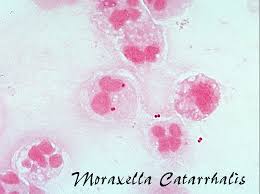
Further, between 50–85% of all children experience at least one acute otitis media (AOM) episode before 3 years of age, , and the disease is associated with high costs.

catarrhalis is the third most frequent bacterial pathogen causing otitis media disease in children (after Streptococcus pneumoniae and non-typeable Haemophilus influenzae (NTHI)), and is a major cause of exacerbations in adults with chronic obstructive pulmonary disease (COPD). Moraxella catarrhalis is a gram-negative aerobic diplococcus and an exclusive human respiratory pathogen that for a long time used to be considered a purely human commensal. This study comprises one of the most exhaustive studies to identify potential vaccine candidate antigens against the bacterial pathogen M. The most significant protection data were obtained with the antigen MCR_1416 (Msp22), which was further investigated for its biological function by in vitro studies suggesting that Msp22 is a heme binding protein. Eight of the 23 candidates were tested in a Moraxella mouse pulmonary clearance model, and 3 of these antigens induced significantly faster bacterial clearance compared to adjuvant or to the previously characterized antigen OmpCD. This ANTIGENome technology led to the identification of 214 antigens, 23 of which were selected by in vitro or in vivo studies for additional characterization. catarrhalis vaccine candidate antigens, we used carefully selected sera from children with otitis media and healthy individuals to screen small-fragment genomic libraries that are expressed to display frame-selected peptides on a bacterial cell surface.


Moraxella catarrhalis is one of the three most common causative bacterial pathogens of otitis media, however no effective vaccine against M.


 0 kommentar(er)
0 kommentar(er)
